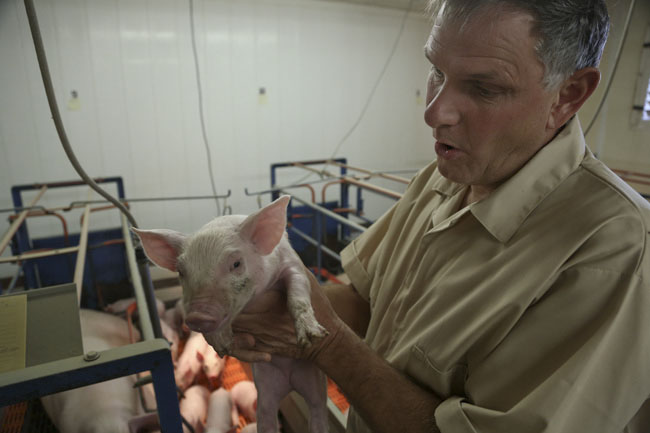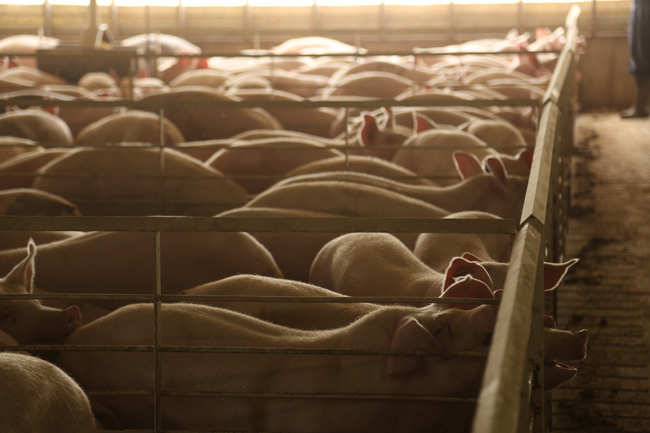
This story is sponsored by the Minnesota Pork Board.
This is the last piece in a three part series from the Minnesota Pork Board. We want to answer your questions. Leave a comment, tweet us @MinnesotaPork, post a question on the Minnesota Pork Facebook page or send us an inquiry via www.Pig3D.com if you have any questions.
By Laurie Kesteloot
1. Are there general guidelines/audits for farmers and ranchers to ensure they are doing right?
The National Pork Board and the American Association of Swine Veterinarians offer guidelines on how pigs should be raised. They address issues such as animal housing, health and nutrition, and animal well-being. They also have developed an education and certification program for farmers that is designed to ensure that pigs are raised in a humane way and that the highest quality meat is provided to consumers.
2. Is corporate farming sustainable farming?
The term corporate farming is always a bit confusing because there is no true definition of a corporate farm. Our family — and many families like us — has incorporated our farm as more family members have become involved. Does this make us a corporate farm? Maybe. Are we still a family farm? Definitely. One thing that is for certain is that modern farming is sustainable. The techniques farmers use today allow us to produce more food much more efficiently and with fewer resources than in the past. A study done by the National Pork Board found that each pound of pork produced in 2009 used 41 percent less water and 78 percent less land, and had a 36 percent lower carbon footprint when compared with pork production in 1959.

3. Is it required that meat sold at the store identify if animals have been given hormones or other drugs/chemicals?
It is illegal to give pigs hormones. The “no added hormones” labeling was developed as a marketing strategy to give consumers the impression that these products are safer and healthier than those of the competition. It is nothing more than a ploy to get customers to choose one product over another. There is no requirement to label meat that has been treated with medications; however, withdrawal periods are followed to ensure there is no residual medication in the meat when it is processed.
4. Is there truly a difference in the quality of pork/meat when antibiotics are used?
I have never seen evidence that suggests that the quality of meat is compromised when antibiotics are used. Antibiotics are used under the guidance of veterinarians, and only when necessary to keep animals healthy. We keep a record of which pigs were treated with antibiotics and there are strict withdrawal periods that farmers must follow to ensure no trace of any medication is left in the meat when it is processed. Meat is regularly tested at the processing plants and farmers face strict consequences if these withdrawal times are not met.
5. What does free range really mean?
Free-range is defined differently from person to person. Consumers often envision livestock raised outdoors without the boundaries of fencing or another sort of enclosure. As farmers, we know this is not a reality. Livestock needs to be fenced or housed indoors in order to keep the animals from wandering off and also to protect them from predators and the elements. The USDA defines free range as continuous access to the outdoors during the production cycle for poultry production, but has no definition for the production of pork or beef.

6. Why is thick-cut bacon so much better than the regular stuff? Any tips on how to best prepare pork?
Thick cut is better because you get more bacon with each slice! It’s a personal preference as to which is better. Personally, I think bacon is delicious no matter how it is cut. As for preparing pork, one thing to be mindful of is not to overcook it. It should be cooked to 145°F, then given a few minutes to rest before being sliced and served.
7. What is the difference between natural and organic labels on food? Can any farmer simply label food natural or organic? What is the standard?
To have a natural label a food must be minimally processed and contain no artificial ingredients. Natural labeling refers only to the processing of meat, and there are no standards regarding farming practices. The official USDA Organic Seal can be used only if the producer complies with standards for organic production. These include standards addressing animal health and welfare, animal housing, and the use of organic feed.

8. How can I find out where my meat comes from?
Meat is most commonly not labeled with a place of origin as produce is, although country of origin is required. I would encourage anyone who would like to learn more about where their food comes from to ask a farmer. I, along with most other farmers I know, am very proud of my family’s farm and would love the opportunity to share what we do with the consumers of the food we produce.
9. Do you see a loss in small, local farms? Is it due to the younger generation not coming back to the family farm?
There has been some loss in smaller farms over time, and the average age of farmers is increasing. I’m sure fewer kids and young adults coming back to the family farm is a factor in this shift. But, as farm sizes have gradually grown over the years, farmers have more resources and are able to grow food much more efficiently than before.
